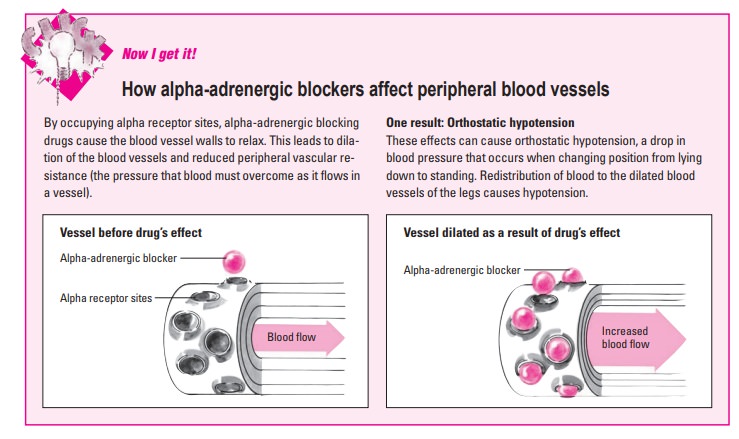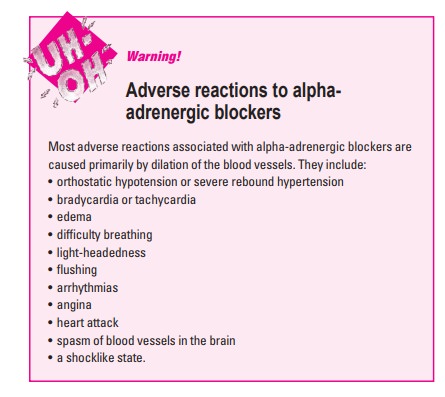Chapter: Clinical Pharmacology: Autonomic nervous system drugs
Alpha-adrenergic blockers
Adrenergic blocking drugs
Adrenergic blocking drugs, also called sympatholytic drugs, areused to disrupt sympathetic nervous system function. These drugs work by blocking impulse transmission (and thus sympathetic nervous system stimulation) at adrenergic neurons or adrenergic receptor sites. Their action at these sites can be exerted by:
§ interrupting the action of adrenergic (sympathomimetic) drugs
§ reducing available norepinephrine
§ preventing the action of cholinergic drugs.
Classified information
Adrenergic blocking drugs are classified according to their site of action as:
· alpha-adrenergic blockers (or alpha blockers)
· beta-adrenergic blockers (or beta blockers).
Alpha-adrenergic blockers
Alpha-adrenergic blockers work by interrupting the actions of thecatecholamines epinephrine and norepinephrine at alpha recep-tors. This results in:
· relaxation of the smooth muscle in blood vessels
· increased dilation of blood vessels
· decreased blood pressure.
Drugs in this class include:
· alfuzosin
· ergoloid mesylates
· phenoxybenzamine
· phentolamine
· prazosin, doxazosin, and terazosin
· tamsulosin.
A mixed bag
Ergotamine is a mixed alpha agonist and antagonist; at high doses, it acts as an alpha-adrenergic blocker.
Pharmacokinetics
The action of alpha-adrenergic blockers in the body isn’t well un-derstood. Most of these drugs are absorbed erratically when ad-ministered orally, and more rapidly and completely when adminis-tered sublingually. Alpha-adrenergic blockers vary considerably in their onset of action, peak concentration levels, and duration of action.
Pharmacodynamics
Alpha-adrenergic blockers work in one of two ways:
· They interfere with or block the synthesis, storage, release, and reuptake of norepinephrine by neurons.
· They antagonize epinephrine, norepinephrine, or adrenergic (sympathomimetic) drugs at alpha receptor sites.
Not very discriminating
Alpha-adrenergic blockers include drugs that block stimulation of alpha1 receptors and that may block alpha2 receptors.
Reducing resistance
Alpha-adrenergic blockers occupy alpha receptor sites on the smooth muscle of blood vessels. (See How alpha-adrenergicblockers affect peripheral blood vessels.)
This prevents catecholamines from occupying and stimulating the receptor sites. As a result, blood vessels dilate, increasing local blood flow to the skin and other organs. The decreased periph-eral vascular resistance (resistance to blood flow) helps to de-crease blood pressure.

Sympathetic response?
The therapeutic effect of an alpha-adrenergic blocker depends on the sympathetic tone (the state of partial constriction of blood vessels) in the body before the drug is administered. For instance, when the drug is given with the patient lying down, only a small change in blood pressure occurs. In this position, the sympathetic nerves release very little norepinephrine.
Patient up, pressure down
On the other hand, when a patient stands up, norepinephrine is re-leased to constrict the veins and shoot blood back up to the heart. If the patient receives an alpha-adrenergic blocker, however, the veins can’t constrict and blood pools in the legs. Because blood re-turn to the heart is reduced, blood pressure drops. This drop in blood pressure that occurs when a person stands up is called or-thostatic hypotension.
Pharmacotherapeutics
Because alpha-adrenergic blockers cause smooth muscles to relax and blood vessels to dilate, they increase local blood flow to the skin and other organs and reduce blood pressure. As a result, they’re used to treat:
· benign prostatic hypertrophy
· hypertension
· peripheral vascular disorders (diseases of the blood vessels of the extremities), especially those in which blood vessel spasm causes poor local blood flow, such as Raynaud’s disease (intermit-tent pallor, cyanosis, or redness of fingers), acrocyanosis (sym-metrical mottled cyanosis of the hands and feet), and frostbite
· pheochromocytoma (a catecholamine-secreting tumor that causes severe hypertension).
Drug interactions
Many drugs interact with alpha-adrenergic blockers, producing a synergistic, or exaggerated, effect. The most serious interactions are severe hypotension and vascular collapse.
These interactions can occur when these drugs are taken with ergoloid mesylates and ergotamine:
· Caffeine and macrolide antibiotics can increase the effects of ergotamine.
· Dopamine increases the pressor (rising blood pressure) effect.

· Nitroglycerin can produce hypotension from excessive dilation of blood vessels.
Sympathomimetics, including many over-the-counter drugs, can increase the stimulating effects on the heart, possibly resulting in hypotension with rebound hypertension. (See Adverse reactionsto alpha-adrenergic blockers.)
Related Topics